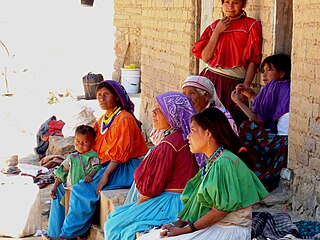
The Uto-Aztecan languages are a family of indigenous languages of the Americas, consisting of over thirty languages. Uto-Aztecan languages are found almost entirely in the Western United States and Mexico. The name of the language family reflects the common ancestry of the Ute language of Utah and the Nahuan languages of Mexico.

Coahuiltecan was a proposed language family in John Wesley Powell's 1891 classification of Native American languages. Most linguists now reject the view that the Coahuiltecan peoples of southern Texas and adjacent Mexico spoke a single or related languages. Coahuiltecan continues to be a convenient collective term for the languages and people of this region.

The Huichol or Wixárika are an indigenous people of Mexico and the United States living in the Sierra Madre Occidental range in the states of Nayarit, Jalisco, Zacatecas, and Durango, as well as in the United States in the states of California, Arizona, New Mexico, and Texas. They are best known to the larger world as the Huichol, although they refer to themselves as Wixáritari in their native Huichol language. The adjectival form of Wixáritari and name for their own language is Wixárika.

Comecrudan refers to a group of possibly related languages spoken in the southernmost part of Texas and in northern Mexico along the Rio Grande of which Comecrudo is the best known. These were spoken by the Comecrudo people. Very little is known about these languages or the people who spoke them. Knowledge of them primarily consists of word lists collected by European missionaries and explorers. All Comecrudan languages are extinct.
Comecrudo is an extinct Pakawan language of Mexico. The name Comecrudo is Spanish for "eat-raw". It was best recorded in a list of 148 words in 1829 by French botanist Jean Louis Berlandier. It was spoken on the lower Rio Grande near Reynosa, Tamaulipas, in Mexico. Comecrudo has often been considered a Coahuiltecan language although most linguists now consider the relationship between them unprovable due to the lack of information.

Coahuilteco was one of the Pakawan languages that was spoken in southern Texas and northeastern Coahuila (Mexico). It is now extinct.

The Nahuan or Aztecan languages are those languages of the Uto-Aztecan language family that have undergone a sound change, known as Whorf's law, that changed an original *t to before *a. Subsequently, some Nahuan languages have changed this to or back to, but it can still be seen that the language went through a stage. The best known Nahuan language is Nahuatl. Nahuatl is spoken by about 1.7 million Nahua peoples.
Tubar or Tubare, is an extinct language of southern Chihuahua, Mexico that belonged to the Uto-Aztecan language family.
The Huichol language is an indigenous language of Mexico which belongs to the Uto-Aztecan language family. It is spoken by the ethnic group widely known as the Huichol, whose mountainous territory extends over portions of the Mexican states of Jalisco, San Luis Potosí, Nayarit, Zacatecas, and Durango, mostly in Jalisco. United States: La Habra, California; Houston, Texas. Under the 2003 Law on Indigenous Language Rights, the indigenous languages of Mexico along with Spanish are recognized as "national languages".
Cora is an indigenous language of Mexico of the Uto-Aztecan language family, spoken by approximately 30,000 people. It is spoken by the ethnic group that is widely known as the Cora, but who refer to themselves as Naáyarite. The Cora inhabit the northern sierra of the Mexican state Nayarit which is named after its indigenous inhabitants. A significant portion of Cora speakers have formed an expatriate community along the southwestern part of Colorado in the United States. Cora is a Mesoamerican language and shows many of the traits defining the Mesoamerican Linguistic Area. Under the General Law of Linguistic Rights of the Indigenous Peoples, it is recognized as a "national language", along with 62 other indigenous languages and Spanish which have the same "validity" in Mexico.

The Tarahumara language is a Mexican Indigenous language of the Uto-Aztecan language family spoken by around 70,000 Tarahumara (Rarámuri/Ralámuli) people in the state of Chihuahua, according to a 2002 census conducted by the government of Mexico.

Ópata is either of two closely related Uto-Aztecan languages, Teguima and Eudeve, spoken by the Opata people of northern central Sonora in Mexico and Southeast of Arizona in the United States. It was believed to be dead already in 1930, and Carl Sofus Lumholtz reported the Opata to have become "Mexicanized" and lost their language and customs already when traveling through Sonora in the 1890s.

Quinigua (Kiniwa) is an extinct language that was spoken in northeastern Mexico. Quinigua was spoken between the Sierra Madre Oriental and the Sierra Tamaulipa la Nueva, and between the Rio Grande and the Rio del Pilón Grande. It has no apparent relatives and remains unclassified.

The Tepecano language is an extinct indigenous language of Mexico belonging to the Uto-Aztecan language-family. It was formerly spoken by a small group of people in Azqueltán, Jalisco, a small village on the Río Bolaños in the far northern part of the state, just east of the territory of the Huichol people. Most closely related to Southern Tepehuán of the state of Durango, Tepecano was a Mesoamerican language and evinced many of the traits that define the Mesoamerican Linguistic Area. So far as is known, the last speaker of Tepecano was Lino de la Rosa, who was still living as of February 1980.

Cazcan or Caxcan (Kaskán), was the language of the Caxcan, one of the Chichimeca peoples of Mexico. It is known only from a few word lists recorded in the 16th and 17th centuries. The language was definitely part of the Uto-Aztecan family, probably related to Huichol or possibly Southern Tepehuan. There appear to have been dialectal differences between the major Caxcan valleys, and it is likely that several other languages were spoken in Caxcan territory.

The Coahuiltecan were various small, autonomous bands of Native Americans who inhabited the Rio Grande valley in what is now northeastern Mexico and southern Texas. The various Coahuiltecan groups were hunter gatherers. First encountered by Europeans in the 16th century, their population declined due to European diseases, slavery, and numerous small-scale wars fought against the Spanish, criollo, Apache, and other Indigenous groups.
The Pakawan languages were a small language family spoken in what is today northern Mexico and southern Texas. Some Pakawan languages are today sleeping. While others are engage in revitalizations and thus awakening.
The Comecrudo people were an Indigenous people of Mexico, who lived in the northern state of Tamaulipas. They were a Coahuiltecan people.
The Tap Pilam Coahuiltecan Nation is a cultural heritage organization of individuals who identify as lineal descendants of the Coahuiltecan people. They have a nonprofit organization, the American Indians in Texas-Spanish Colonial Missions, based in San Antonio, Texas.











